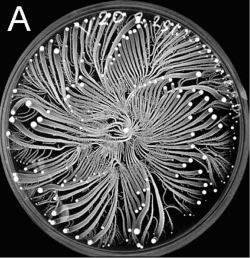A visual representation of bacterial communication systems
How do living organisms communicate and connect with the external? How is that structured and how much of it is comparable to the communication networks of the non-living? Is it valid to state that the communication networks of modern infrastructures are a projection of the communication networks built among the living?
STREPTOMYCES
1st step: Streptomyces isolation from pure soil
I. Air dry the soil samples for 3-4 h at 45° to select for Actinomyces spores, considering that many other bacteria die during this pre-treatment
II. Plate the samples either on to Actinomycete Isolation Agar (AIA) or Mannitol Soy Flour Agar (MSA)
Necessities for the recipe of Mannitol Soy Flour Agar
In a 250 mL conical flask mix:
- 2g Agar
- 2g Mannitol
- 2g Soya flour (Holland and Barrett)
- 10 mM CaCl2
- 100 mL Deionised water
III. Incubate at 30°C for 7 days
Optional: Supplementation with cyclohexamide (50 μg/ml) and nystatin (50 μg/ml) to further remove competing bacteria
2nd step: Adding beef extract
The beef extract is added in order to identify the possible communication pathways of Streptomyces when it comes to nutrition.
PAENIBACILLUS VORTEX
Currently waiting for the bacterial strain to get delivered from Jena
- Considering the pattern-forming abilities of Paenibacillus Vortex, I am interested in depicting the possible networks this bacterium can build through quorum sensing, when it comes to the presence of nutrition. Known as one of the most intelligent bacterium species due to its advanced quorum sensing, PV might as well be the proper organism to give clear and differential communication structures.
1st step: Isolation and incubation
2nd step: Adding Pepton
Inspiration: http://orielisar.com/ - Ori Elisar http://www.nuritbarshai.com/objectivity/ - Nurit Bar-Shai http://annadumitriu.tumblr.com/ - Anna Dumitriu https://exploringtheinvisible.com/ - Dr. Simon Park
